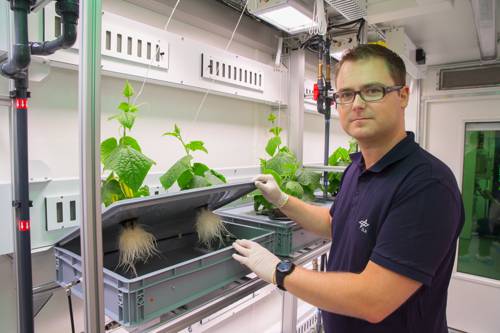
FAQ About Indoor Plant Aeroponics Systems

What is an indoor plant aeroponics system?
An indoor plant aeroponics system is a method of growing plants without soil by suspending the roots in the air and regularly misting them with a nutrient-rich water solution. This method allows for better oxygenation and nutrient absorption, promoting faster growth and healthier plants. It's particularly popular for growing vegetables, herbs, and ornamental plants indoors.

How does an aeroponics system differ from hydroponics?
While both aeroponics and hydroponics are methods of growing plants without soil, they differ in how they deliver nutrients to the plants. In hydroponics, roots are submerged in a nutrient solution, while in aeroponics, roots are suspended in air and misted with the nutrient solution. Aeroponics generally provides better oxygenation to the roots, potentially leading to faster growth.

What are the benefits of using an indoor aeroponics system?
Indoor aeroponics systems offer several benefits, including faster plant growth due to enhanced oxygenation, reduced use of water and nutrients, and the ability to grow plants in limited space. The systems are often cleaner and reduce the likelihood of soil-borne diseases, making them ideal for indoor environments.

What types of plants can be grown in an indoor aeroponics system?
A wide variety of plants can be grown using an indoor aeroponics system, including leafy greens such as lettuce and spinach, herbs like basil and mint, and even fruiting plants like tomatoes and strawberries. Ornamental plants and some houseplants can also thrive in aeroponic systems.

How do you set up an indoor aeroponics system?
Setting up an indoor aeroponics system involves several steps: choosing the correct system size, assembling the frame, installing the misting equipment, and setting up the nutrient reservoir. After assembling these components, plants are added to net pots, and the system is started to ensure the roots receive a regular misting of nutrient solution.

What maintenance do indoor aeroponics systems require?
Regular maintenance of an indoor aeroponics system includes checking the nutrient solution levels, pH balance, and cleaning the misting nozzles to prevent clogging. It's also essential to monitor plant health, root development, and adjust the nutrient solution according to the plant's growth stages.

What equipment is needed for an indoor aeroponics system?
An indoor aeroponics system typically requires a frame or tower structure to support the plants, net pots, a reservoir for the nutrient solution, a pump, misting nozzles or a fogger, and sometimes a grow light if natural light is insufficient. A timer for the misting system is also recommended to ensure consistent nutrient delivery.

Are aeroponics systems energy efficient?
Aeroponics systems can be energy efficient, especially when compared to traditional soil gardening methods. They use significantly less water and nutrients, and while they do require energy to run the pumps and possibly grow lights, they are designed to optimize the availability of resources to the plants.

Can aeroponics systems be used year-round indoors?
Yes, aeroponics systems can be used year-round indoors. By controlling the indoor environment, including temperature, light, and humidity, you can adapt the system to suit the requirements of different plants regardless of the season.

How do you choose the right nutrient solution for an aeroponics system?
Choosing the right nutrient solution for an aeroponics system depends on the specific plants you are growing. Most suppliers provide pre-formulated solutions tailored for different plant types, but creating a custom mix by balancing macronutrients and micronutrients based on your plants' needs is also an option. Adjusting the nutrient concentration as plants grow is essential for optimal results.

What are common problems with indoor aeroponics systems and how can they be fixed?
Common problems with indoor aeroponics systems include clogged nozzles, nutrient imbalances, and root rot. To fix these issues, regularly clean and check the misting nozzles, monitor and adjust the nutrient solution concentration, and ensure proper aeration to prevent root rot by maintaining adequate air circulation around the roots.

Is an aeroponics system suitable for beginners?
An indoor aeroponics system can be suitable for beginners, but it does require some initial learning about nutrient balancing and system maintenance. Beginners can start with a simple setup and gradually expand as they gain more experience. Many companies provide kits with detailed instructions to facilitate the process.

How much does a typical indoor aeroponics system cost?
The cost of an indoor aeroponics system can vary widely based on size, brand, and complexity. Basic systems for home growers might start around $100-200, while larger or more advanced setups can range from $500 to several thousand dollars. It's essential to consider long-term investment and benefits when evaluating the cost.

How often should the nutrient solution be changed in an aeroponics system?
The nutrient solution in an aeroponics system should be changed every 1 to 2 weeks to ensure the nutrient balance remains optimal for plant growth. Regularly changing the solution helps prevent the build-up of salts and ensures that plants receive the necessary nutrients for healthy development.

Can aeroponics systems help with pest control?
While aeroponics systems can reduce the risk of soil-borne pests and diseases, they do not entirely eliminate pest problems. Indoor systems benefit from being in a controlled environment, which can limit exposure to pests, but regular monitoring and integrated pest management practices are still recommended to control issues effectively.

What is the role of the timer in an aeroponics system?
The timer in an aeroponics system controls the frequency and duration of nutrient misting to the plant roots. It is essential for ensuring that plants receive consistent nutrient delivery without over- or under-watering. Setting an appropriate timer schedule is crucial for maintaining plant health.

Do plants grow faster in aeroponics systems compared to traditional soil growing?
Yes, plants generally grow faster in aeroponics systems compared to traditional soil-based growing methods. The increased oxygenation and direct nutrient delivery to the roots in aeroponics systems promote more efficient growth and can lead to quicker harvesting times.

How can natural sunlight be supplemented in an indoor aeroponics system?
If natural sunlight is insufficient for an indoor aeroponics system, grow lights can be used to provide the necessary light spectrum for photosynthesis. LED grow lights are often recommended due to their energy efficiency and ability to emit specific light wavelengths required for plant growth.

How do you prevent root rot in an aeroponics system?
To prevent root rot in an aeroponics system, ensure that the roots receive adequate oxygenation by maintaining a consistent misting schedule and using well-maintained misting equipment. Proper air circulation in the growing area and keeping the system clean to avoid microbial build-up is also important.

Is it possible to build a DIY indoor aeroponics system?
Yes, it is possible to build a DIY indoor aeroponics system. Many hobbyists create systems using readily available materials like PVC pipes, plastic containers, and aquarium pumps. Online resources and community forums can provide guidance and schematics for building a cost-effective, custom aeroponics system.
